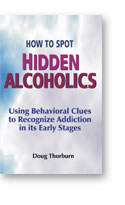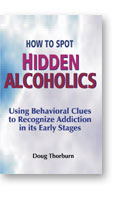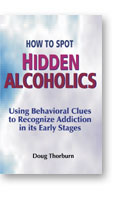 |
|
Issue # 77 - Spring/Summer 2014
|
|
Viewing the news through the lens of alcohol and other-drug addiction
The recent hiatus from the Thorburn Addiction Report was not due to a lack of stories—alcoholism is always in the news—but rather due to a dearth of twists and hidden gems in the stories that others overlook.
I also like to be thorough in reporting. I could have covered the death of Mickey Rooney; his story should be told alongside countless other child stars, many of whom became stars due to a parent’s alcoholism-fueled egomania and in whom a latent inherited alcoholism was later triggered. But that could require a book.
Additionally, I detest pathological lying. I would love to be able to prove that such lying is nearly always linked to substance addiction. Despite having spent an inordinate amount of time the last six months studying many of those currently making history—for better or worse—I cannot prove that Harry Reid or others like him are addicted to alcohol or pills. Not every misbehavior can be proven to be caused by substance addiction.
We never know what might pop up from the archives, suddenly becoming relevant due to current events. I have known since 2005 that an Iraqi defector, code name “Curveball,” triggered the Iraq war as only an alcoholic could. The story has become more relevant recently with the unfolding ISIS crisis, earning Top Story honors.
In future issues I will ask why many recovering alcoholics get the concept that protecting addicts from the consequences of their misbehaviors perpetuates addiction, but doing this for the poor somehow doesn’t perpetuate poverty. I will also show that the principles of AA are libertarian ones. The next issue will include a review of either Tyrant (FX) or a recent episode or two of Major Crimes (TNT) which, in the meantime, I’ll recommend as among the greatest portrayals of alcoholism on the small screen. And, while Major Crimes (a spin-off of the excellent The Closer) is really good, Tyrant is, simply, extraordinary television-making and story-telling.
Please read on, discover new ideas—and enjoy!
|
|

|
|
Welcome to the Thorburn Addiction Report in which we interpret the news through the lens of alcohol and other drug addiction. Each month, we bring you several sections, including:
1. Top Story of the month along with runners up, persons under watch, enablers, disenablers and more
2. Review or Public Policy Recommendation of the month
3. Dear Doug in which a recent letter to "Dear Annie" or other "help" column is rewritten, with responses given from the unique perspective that alcohol or other drug addiction best explains the misbehaviors described
4. Alcoholic Myth-of-the-Month
5. Alcoholic Antic-of-the-Month, usually where someone deserves the Darwin Award, but lived.
There is something for everyone!
Addiction Report Archives here
© 2014 by Doug Thorburn
|
|
The blog is open to your comments. We’ll be interested in any thoughts you, our loyal readers, may have.
All four books are available on Amazon, and the two e-books are available in multiple formats on IPG.
  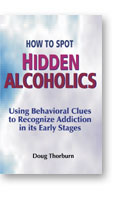 
|
|

Iraq: How An Alcoholic Triggered a War, Which Led to a Quagmire
Whether alcoholics are directly or indirectly responsible for catastrophes, the lies they tell can lead to many forms of tragedy, especially when politics is involved. The 2003 Iraq war and current ISIS disaster in Iraq is a classic example of a series of catastrophic events initiated indirectly by one alcoholic.
Excluding natural causes, my work indicates that alcohol and other-drug addicts are responsible for some 80% of human misery. Considering that only 10% of the population is afflicted with substance addiction, the disease affects others way out of proportion to its prevalence. These problems include everything from auto accidents and domestic violence to war and genocide.
Confirming this 80% figure is difficult because of how the disease works. While statistics for road fatalities show the cause was a driver under the influence in only about a third of cases, many instances of addiction are missed. In some, the particular drug isn’t tested in perpetrator or apparent victim; both may have contributed to the incident. In others the addict was between using episodes, when behavior is often worse than while under the influence. Other cases involve accidents for which the precipitating event was an alcoholic driver who drove in a way that caused other, unrelated parties to crash. When natural causes are eliminated, the true cause of road fatalities in arguably 80% of instances is substance addiction.
Studies cited in Drunks, Drugs & Debits: How to Recognize Addicts and Avoid Financial Abuse show domestic violence crimes are nearly always rooted in alcoholism. Cases of pre-meditated murder, on the other hand, aren’t so clear-cut. Only about half can clearly be traced to an addict. This figure is misleading because in order to plan, keep a clear head and commit the crime the addict, who can exhibit extraordinary self-control over use during the early stages of the disease, may intentionally stop using for a period of time. This is probably less true for unplanned crimes of passion, which can be more frequently traced to an addict. Unfortunately, those investigating and writing about these violent crimes don’t understand the relevance of addiction and, as a result, don’t mention its likelihood. Ann Rule wrote an autobiographical-biographical true crime book about serial killer Ted Bundy, after working alongside him in a crisis hotline center. Rule never considered the possibility that Bundy might be an alcoholic; when I asked her if she thought it relevant, she blew me off. Anthrax killer Bruce Ivins (TAR # 42) could be identified as an addict in only one news article of a dozen I read after his suicide—in the 28th paragraph.
Other than my work, especially TAR, little has been written on the link between addiction and war—authorized murder on a massive scale. Yet it’s probable that those who precipitate international conflict are as likely to be substance addicts as those who commit domestic abuse. Non-addiction aware writers don’t understand cause and effect—that addiction is almost always the root cause of egomania, which can take form in a need to wield power over others, resulting in violence. Since most addicts don’t commit murder, even those journalists, biographers and historians who are addicts themselves don’t connect the dots between addiction and war.
Josef Stalin, arguably the worst murderer of all time, was not identified as an alcoholic by most of his biographers. However, James Graham demonstrates in The Secret History of Alcoholism that his behaviors were in fact fueled by alcoholic egomania. Most of Adolf Hitler’s biographers missed his addiction, even though a number of his closest confidants were outed as addicts; addicts often flock together. In their 1978 book, The Medical Casebook of Adolf Hitler, Leonard L. Heston and Renate Heston show his amphetamine use, which caused his Parkinson disease-like symptoms, to be the best explanation for his increasingly reckless and destructive behavior. Mao Tse-tung (aka Mao Zedong), who was responsible for the deaths of some 50-100 million Chinese, was outed as a barbiturate addict by his personal physician, Dr. Li Zhisui, in The Private Life of Chairman Mao.
Even when addictive drug use can’t be proved, horrendous misbehaviors indicate addiction. There is no direct proof that Pol Pot, who was responsible for the murder of about a third of his Cambodian countrymen, was an alcoholic; however, his horrific behaviors are consistent with the diagnosis. Proof exists of Che Guevarra’s alcoholism, but fortunately he never became head of state. On the other hand, he clearly influenced and was buddies with Fidel Castro, who was probably an amphetamine addict (try giving seven-hour speeches on just caffeine!). Castro, in turn, sent his henchmen to foment violent revolutions throughout Africa and Central and South America. Yasir Arafat, whose behaviors and pupil size in numerous pictures indicate amphetamine addiction (TAR # 4), acted similarly in the Middle East. A head of state inflicting massive pain on his own people or committing acts of aggression against others, or both, is most likely an undiagnosed addict. Such acts may also be committed by people who are not themselves addicts but instead profoundly influenced by addicts, even when well-intentioned.
Along these lines, I believe George W. Bush’s intervention in Iraq was with the best of intentions. Because Saddam Hussein and his sons, Uday and Qusay, were alcoholics, if there was any chance they had access to WMD or if there was a chance they committed even a third of the killings ascribed to his regime, all three should have been taken out.* When the war wasn’t going well, Bush’s 2007-2008 “surge,” engineered by General David Petraeus (featured in TAR # 72), brought an extraordinary relative peace to Iraq; American fatalities were below accidents in the U.S. military for entire the year. Only when the U.S. pulled out in 2011 was the stage set for the intractable problems now faced.
Troops were never removed from Germany or Japan after WWII, nor were they removed from Korea after the Korean War. This arguably has helped keep the peace in these countries, so far, for more than 60 years. Brent Scowcroft, the national security advisor during the first four years of the George W. Bush administration who opposed our 2003 invasion of Iraq, wrote in 2008 that Iraq wouldn’t be ready to go on its own for quite a while and leaving prematurely would set the stage for the enormous problems the country is now facing.
It’s unfortunate that the war is now being reported as an unsupported farce that President Bush used to advance his own agenda. It’s important to look at the facts, as known pre-war:
-
Saddam, a Sunni Muslim: (1) committed genocide against Kurds, Shiites and Marsh Arabs; (2) was responsible for the deaths of 1 million of his own people, or 40,000 per year for each year he ruled Iraq; (3) attacked four of his neighbor countries; (4) paid bounties for suicide bombers on the West Bank; and (5) harbored known global terrorists.
-
Then-President Bill Clinton signed into law the Iraq Liberation Act of 1998, which supported regime change in Iraq, mainly because of the dangers of Saddam Hussein’s WMD.
-
In 2002, both houses of Congress voted overwhelmingly (296-133 in the House and 77-23 in the Senate) to pass a resolution authorizing Saddam’s removal by force. Senators Joe Biden, Harry Reid, Hillary Clinton and John Kerry gave impassioned speeches why we should depose Saddam. Congresswoman Nancy Pelosi lectured on the dangers of Saddam’s stockpiles of WMD. The war was legally authorized by many who now feign ignorance or who conveniently “forget” their personal support for the war.**
-
Along with 70% of Americans, both right-wing and left-wing journalists supported the war, from Fox News and George Will to Thomas Friedman and The New York Times.
In Curveball: Spies, Lies, and the Con Man Who Caused a War, Los Angeles Times correspondent Bob Drogin shows that a single Iraqi defector, a chemical engineer code named “Curveball,” precipitated the 2003 Iraq invasion by inventing confabulated lies about weapons of mass destruction purportedly controlled by Saddam Hussein. U.S. President George W. Bush, a recovering poly-drug addict, spear-headed a war intended to take down the alcoholic Saddam. The great irony is Curveball is also an alcoholic.
In November 1999, Curveball found his way to Germany as an Iraqi defector seeking political asylum and hoping for “a huge house and…a gleaming Mercedes sedan with buttery soft leather seats” (already, a behavioral clue to Curveball’s addiction: grandiose expectations). Because German immigration granted asylum to only one in 25 applicants and everyone in Baghdad knew only those with good information were given red-carpet treatment, he offered valuable “secrets” of the Saddam regime. He told the German intelligence apparatus that Saddam had a secret program to churn out germ weapons.
Long before Curveball’s defection, the German intelligence agency BND and the American CIA learned to distrust each other. On one hand, the collapse of East Germany provided proof that Soviet bloc spies had “completely penetrated the upper echelons of West German intelligence.” On the other, “arrogant CIA experts patronized and insulted” the BND, with the CIA going so far as to set up a German station chief in Washington, DC for a fall from grace for supposedly passing out in a gay bar (which could have subjected him to blackmail), even though he was a notorious womanizer.
A former senior officer with the chief intelligence wing at the Pentagon that handled defectors, the Defense Intelligence Agency (DIA), explained it’s difficult to “assess someone if you don’t see his face, his style, his mannerisms, what he’s saying, how he responds. All of that is very important in judging someone’s credibility.” However, the grudge the Germans held against the American intelligence services caused Curveball’s case officer to argue emphatically against letting his U.S. counterparts access to an important defector whom “he and his colleagues were perfectly capable of debriefing…without American help.”
Moreover, if a defector brought information that might reflect badly on Germany, the Germans’ reasons to refuse to allow others access were compounded. Curveball told his handlers that Saddam used German-manufactured equipment to build WMD. This was deeply embarrassing to Germans, who could suffer political ramifications if German companies, after building a poison gas factory for Libyan ruler Muammar Qaddafi and providing all sorts of components and expertise for Saddam before the Persian Gulf War in 1991, were again found to be providing anything that might be deemed similar to modern gas chambers. This could spell disaster to the intelligence experts working under the German national coordinator of intelligence, Ernst Uhrlau (who admitted to controlling underlings via tirades for which he became infamous and under whom, as a result, morale plummeted).
U.S. intelligence reluctantly came to accept the fact its agents would not be allowed to meet with Curveball and had to depend on the Germans.
Non-intelligence service German operatives with access to Curveball were simply scientists; they didn’t have a clue about reading people or how to properly interrogate. Curveball described a technically feasible system of mobile germ-brewing big-rigs, plausible for a regime bent on rebuilding a WMD program. There were many kernels of truth wrapped inside his confabulations. Gaps were explained away; he was a chemical engineer, not a microbiologist or weapons expert and couldn’t be expected to know everything.
Curveball supplied his German handlers with the answers they wanted. Translations from Arabic to German also caused intelligence bureaucrats to fill in gaps where something didn’t make perfect sense. In filling gaps, preconceived notions caused them to err on the side of “Saddam has WMD.” Translating to English increased the errors.
The Americans were impressed with the reports they read. Saddam had developed an extensive WMD program in the 1980s, which the United Nations Special Commission (UNSCOM) destroyed after the 1991 war. It made sense that a megalomaniacal dictator would reconstruct what he could, when he could. Bioweapons were the perfect instrument because of their seemingly innocuous civilian applications, from medicine to pesticides. Spinning tales that others would believe was made still easier because “the Americans had failed to recruit a single Iraqi agent…who was close to Saddam’s illicit weapons programs.” By 1998, the U.S. had almost no human on-the-ground intelligence on Saddam or any WMD. The Americans were desperate to fill a void that Curveball was seen as being able to do.
Many intelligence operatives argued that Curveball’s “original information was so exquisitely detailed, so utterly persuasive, that it had to be true.” American intelligence sub-agencies seeking recognition reinforced this belief. Recognition can be important for bureaucrats, even when they are geeky scientists. A group called WINPAC, or Weapons Intelligence, Nonproliferation, and Arms Control, “was supposed to streamline CIA reporting and analysis of weapons-related threats.” The tiny staff of six specializing in microscopic germs and viruses was suddenly deemed important, which gave them credibility and allowed them to push reports up to higher levels.
Curveball’s clearly “erratic behavior,” along with later denials of some of the information he had supplied, suggested to the German operatives they should no longer trust him. But these same operatives know that “memories are fungible, constantly changing….Clarity of recall can evaporate or reformulate in unexpected ways. So they ignored his denials, his backsliding and memory lapses.” Although “his drinking worsened,” they did not think Curveball was an alcoholic; instead, they figured he might be suffering from depression.
Addiction experts, had there been any working in the intelligence services, would have judged Curveball’s claims non-credible. Curveball gradually became a “nervous wreck” and his behavior became increasingly unpredictable. He drove German intelligence crazy, was “mentally unstable” and “drank too much.” He vanished for days at a time, postponed appointments at the last minute and even failed to show up for questioning. He exhibited roller coaster-like “wild mood swings.” He smoked incessantly and signs of paranoia began setting in. He was irresponsible both with money and with his life. Yet, he could switch to fawning charm and a great smile to get what he wanted.
During his stint as an informant, one American was allowed to meet with Curveball. The Germans tried to verify a story in which he may have witnessed an accidental leak of anthrax. Because he would have been vaccinated, he could be tested for antibodies in his blood. German doctors found the lab results inconclusive and asked an American doctor, “Les,” to take a look. While Les, too, couldn’t prove or disprove the presence of such antibodies, he wondered whether Curveball might be an alcoholic. Les later told a colleague, “It was early in the morning, he was hung over and he smelled like booze,” and worried why Curveball would show up for an important medical test with a “blistering hangover” and bloodshot eyes, sallow and sweaty skin and disheveled clothes from (apparently) being out all night. Les’ observations and Curveball’s behaviors are consistent with a diagnosis of alcoholism; as described in many stories of alcoholics in both Drunks, Drugs & Debits and How to Spot Hidden Alcoholics: Using Behavioral Clues to Recognize Addiction in its Early Stages, they are classic symptoms. Of course he was an alcoholic. Therefore, he should not have been trusted.
Aside from the fact that alcoholics, because of their need for control, can be great liars, why would those in both nations’ intelligence services—who frequently deal with liars—have believed him? Disbelief was suspended partly because other alcoholics—the German station chief and Uhrlau, the German national coordinator of intelligence—destroyed trust between U.S. and German agencies, preventing openness. In addition, “confirmation bias,” the tendency to search for, interpret, focus on and remember information in a way that confirms one's preconceptions, helped conceal the truth (http://en.wikipedia.org/wiki/List_of_cognitive_biases). Saddam previously had WMD and everyone knew he was a murderous despot. Why would he stop? Moreover, there was ample evidence of a British-trained microbiologist directing an Iraqi program to research anthrax and other deadly agents before the 1991 war. Dubbed “Dr. Germ,” she admitted Saddam had produced “horrific germ weapons,” which were ordered destroyed after 1991 rather than risk discovery. In the late ‘90s, the intelligence community assumed Saddam was again building germ weapons; all they needed was proof, which Curveball provided. The pieces of the puzzle all seemed to fit together, thanks to confirmation bias and an extremely convincing alcoholic, along with other alcoholics serving to stifle open communication. Without any obvious contradictions, the passage of time served only to cement this view.
When 9-11 happened, German intelligence was close to pulling the plug on Curveball. But the attacks gave more credence to Curveball’s confabulated claims. Despite strong doubts inside the CIA, the Bush White House linked Saddam to the direct attacks and al Qaeda terrorists in general. Bureaucrats and intelligence personnel looking for fame and recognition got in the way of sound analysis. Despite the fact that the Germans told the Americans they couldn’t validate Curveball’s stories and still wouldn’t give Americans access to him, WINPAC rediscovered the Curveball reports and latched onto his story of biological weapons. Drogin cited a skeptical intelligence chief’s analysis of WINPAC: “They figure the mobile weapons labs are their ticket to glory. They’re like a cult….It’s crazy.” And the chief of the European Division in the clandestine service, Tyler Drumheller, preferred to err on the side of caution, acknowledging sometimes even crazy guys turn out to be right. Besides, “the best liars always tell some truth.”
Despite concerns by many in German intelligence, they knew if they pulled the plug those at the very top would have to admit to a mistake. The skeptics would have walked the top guys off a cliff. The Germans could never admit Curveball wasn’t credible; if Curveball was found to be a liar after the Germans had spent a fortune debriefing and protecting him, someone in the German intelligence agency would be held accountable and agents—even top brass—would be fired. They felt forced to judge Curveball’s claims “credible.” This was further complicated by the fact that the U.S. publicly blamed the tragedy, “in part, on the ineptitude of German authorities. Three of the four 9/11 pilots, including Mohammed Atta, the ringleader, had lived up to nine years in Hamburg. They studied at technical colleges and formed an al Qaeda cell. Why didn’t the Germans stop them?” The Germans didn’t want to be blamed again.
In short, Curveball’s snowball had grown to an avalanche. By the time Colin Powell gave his speech in February 2003 on the reasons for invading Iraq, nothing was going to stop the momentum. Rhetoric rose in intensity. The authors of the National Intelligence Estimate report (NIE), which “represents the best collective judgment of the entire intelligence community,” had been given “clear marching orders” to assume the U.S. was going to war. The report, which would normally take up to ten months of drafts and rewrites, took only 19 days to complete. The section on Saddam’s biological warfare program was derived almost entirely from Curveball’s information. The rivalry between intelligence sections served only to push us inexorably to the brink, even as doubts on the intelligence increased.
Alcoholics in power often directly cause war. Curveball demonstrates that addicts can also indirectly cause war—likely from their convincing lies. If Curveball hadn’t got the snowball rolling, the 2003 invasion of Iraq may never have occurred. And right or wrong, Iraq would not be in the mess exacerbated by, as Brent Scowcraft warned against, U.S. troops leaving prematurely. While President Obama is likely not an alcoholic—even if he is the child of an alcoholic father and alcoholic step-father (discussed in TAR # 43)—the addictionologist must wonder how many of his close advisers might be compounding alcoholic lies with alcoholic incompetence.
* I tend toward non-interventionism in foreign affairs, but I believe alcoholic despots who have access to WMD must be removed from power and, barring the complete meltdown of U.S. power that seems to be occurring, the U.S. is the only country on the planet that can remove such despots. I have no problem with allowing our citizens to help take out other despots overseas, ventures for which are currently a state-enforced monopoly. On the other hand, intervention in Iraq’s affairs was done badly. I wrote in my client letter at the time (pp. 7-8 of issue # 15 at http://www.dougthorburn.com/newsbyedition.php, which is a terrific read) that if we were to give Iraqi citizens with diverse religious beliefs a stake in keeping the peace, the Iraqi oilfields should be privatized with equal ownership shares given to every Iraqi adult. Bush is a “big-government” conservative who, lacking an understanding of the role of private property in free markets, unfortunately didn’t do this.
** I wouldn’t be as pissed off about such lies and half-truths if I could prove addiction; among members of Congress, at least, it shows not every pathological liar is an addict and, therefore, addiction can’t explain every such misbehavior. However, there may be much more hidden addiction (House Speaker John Boehner is the most notable exception—his alcoholism is quite obvious) than 27 years ago, when Steven Waldman wrote his seminal piece, “Governing under the influence; Washington alcoholics: their aides protect them, the media shields them,” because of the public perception of alcoholism. Pills may have largely taken the place of booze. I would be shocked if there isn’t as much or more addiction among staffers.
|
|
Runner-up for top story of the month:
Elliot Rodger, 22, who slaughtered six and wounded 13 before killing himself in a Xanax-fueled bloodbath on the streets of Goleta, near the University of California at Santa Barbara. Although reportedly diagnosed with Asperger’s Syndrome (a form of autism), he exhibited numerous signs of psychotropic drug addiction, albeit taking an odd form; by his own admission, he was a virgin and, therefore, didn’t engage in one of the most time-honored ways of wielding power over others: serial Don Juanism. On the other hand, since those with AS lack social skills and do not understand non-verbal cues, this isn’t entirely surprising. His 137-page manifesto exhibits extreme narcissism, twisted fantasies, weird obsessions, rage and confabulated thinking. In classic alcoholic fashion, he blames everyone but himself for his problems. This may have been the horrific result of doctor-enabled addiction, as Xanax is a highly-addictive benzodiazepine.
Codependents of the month:
Most of the people posting comments on a US Weekly report about U.S. Olympic gold medalist soccer player Hope Solo’s arrest on charges of domestic violence. Solo, 32, had well known anger management issues. While the odds of addiction ascribed to domestic violence are about as close to 100% as we can get, it’s remotely possible it could be ascribed to instability. Her father, a Viet Nam War veteran, was in and out of her life as a child and teenager, reconnecting with her only during her college years until his sudden death when she was 25. But, odds are odds: the best explanation for leaving her sister and nephew with “visible injuries” during what one cop called a “big party” and “out of control situation” is that she inherited her father’s addiction.
Typical comments include (with my thoughts in parentheses):
“It seems she has quite a temper. Probably needs anger management classes.” (No, she likely needs sobriety, which will allow her to control her temper.)
“Maybe she's on roids?” (While steroids have been accused of causing rage, this is rarely, if ever, observed unless combined with psychotropic drugs, including the drug alcohol.)
“White trash with money.” (Alcoholics often act like trash—regardless of skin color. And while money enables—it allows addicts to continue using without appropriate consequences for longer periods—money does not cause addiction.)
“Trash is trash and an Olympic medal does not change that. Tanya (sic) Harding went to the Olympics and she is still trash.” (Tonya Harding is an alcoholic. She was, no doubt, drinking when she conspired to have fellow Olympian Nancy Kerrigan attacked before the 1994 Olympic Games. She appears to be in recovery, and is actually quite amusing as a commentator on Smoking Gun Presents: World’s Dumbest… in which she frequently mocks drunks committing stupid acts.)
Sorting by “best comments,” I had to scroll down about 40 comments before finding one that finally nailed it (Suzanne, posting on about June 21, 2014): “I'm just guessing, but it might be time for her to stop drinking.” Considering Solo married former NFL player Jerramy Stevens, arrested for assaulting and injuring her the day before they married, we shouldn’t be surprised that she’s a double-double winner (addict and codependent). Stevens has been charged with DUI twice and convicted once, among numerous other alcoholism-related offenses. There’s little doubt they are birds of a feather.
Future watch:
Metal Flowers Media, which is seeking to cast teenagers ages 13 to 18 who like to “make their own rules and party like a rock star” in a series titled My Teen Life. Kristi Russell, president of the casting company, told AP “this series does not intend to exploit troubled teens, nor glamorize their lifestyle. In fact, the intent is quite the opposite.” They intend to cast teenage alcohol and other-drug addicts; time will tell if the comparison Russell drew with the TV show Intervention, in which addicts are confronted by loved ones and encouraged to seek treatment, is apt.
Enablers of the month:
An unnamed judge, sentencing businessman Shaun Goodman, 42, to a year of work release, not jail, and another judge, modifying Goodman’s conditions of release so he could fly from Olympia, WA to New Jersey to watch the Seattle Seahawks and the Denver Broncos in the Super Bowl. Goodman pleaded guilty to DUI and felony eluding in connection with a drunken chase at speeds reported by his terrified passenger, Henry Griffin, in excess of 100 mph through downtown Olympia. Goodman’s attorney, Paul Strophy, noted that Goodman owns a business and “employs individuals who rely on him to show up for work in order to make sure the business runs smoothly.” First, Goodman won’t show up after he kills or seriously maims someone or himself. Second, a business run by an alcoholic is not one that “runs smoothly.” This was his seventh DUI arrest and fifth DUI conviction. The judges should both be locked up with him and a bottle of vodka. I think one overnight would help them to understand the issues.
The unnamed wife of Khemraj Samlall, who defended her husband as “a great guy,” good husband and father, after Samlall came home drunk after a night out with friends. When she accused him of being a bad father for not spending more time with their two children, he allegedly threatened to kill her while pointing two knives at her. Their son then watched him fetch a red gas can from the backyard, bring it inside, throw fuel on her and their bed, take a lighter from his pocket and try to light the gasoline while winking at the boy. He later claimed he “accidentally” spilled the gasoline on his wife and his attempt to light it was “as a joke.”
Disenabler of the month:
Broward County Judge John “Jay” Hurley, who heard the case in which Khemraj Samlall was charged with aggravated assault with a deadly weapon, requiring a $1 million bond for his release, pending trial. The judges enabling Shaun Goodman could learn a thing or two from Judge Hurley.
Sometimes, it takes an addict:
Felix Dennis, dead of throat cancer at 67. Dennis was a British publisher who pioneered computer and hobbyist magazine publishing in the United Kingdom, and more recently published Maxim and The Week. The addictionologist in us would suggest his addiction caused him to take risks others wouldn’t and, in doing so successfully, become immensely wealthy (Dennis’ estimated worth at death: nearly $1.3 billion). He undoubtedly was a full-on addict. By his own admission, he blew $100 million in one decade on drugs, drink and women and had 14 mistresses on his personal payroll.
Every addict has their stories of craziness or pure dumb luck. In 1970, Dennis and two other editors invited twenty 14- to 18-year-old children to “guest” edit an issue of Oz, a British magazine. The kids included a sexually explicit Rupert the Bear cartoon strip, which resulted in all three editors’ arrests on morals charges, as well as the longest obscenity trial in UK history. The three were convicted on two offences, with Dennis receiving a more lenient sentence because he was, in the judge’s opinion, “much less intelligent” than the others and, therefore, less culpable. The convictions were later quashed on appeal.
This “much less intelligent” individual went on in the early ‘70s to found Kung-Fu Monthly after he saw kids queuing in Soho at 9 am to watch Bruce Lee films. He launched Computer Shopper, a pioneering magazine he eventually sold to Bill Ziff. He insisted on focusing on subscriptions as opposed to newsstand sales, insulating his magazines from the sharp declines that wreaked havoc on the newsstand-dependent rags. The bulk of his wealth was created by co-founding MicroWarehouse in 1987, which pioneered direct IT marketing via high quality catalogues. The company went public in 1992 and sold to a private investment group in 2000.
Of course, it’s entirely possible—and perverse—that Dennis may never have taken the risks that helped him to become immensely wealthy were he not an egomaniacal alcohol and other-drug addict. In addition, were he not an addict he may not have been able to tap into the emotional needs of others. Lucky addicts can get immensely wealthy and, in fact, may impel addicts to get wealthy. However, don’t get any ideas: the unlucky ones end up on the street, or dead.
Note to family, friends and fans of the above: the benefit of the doubt is given by assuming alcoholism (they are either idiots and fundamentally rotten, or they are alcoholic/other drug addicts—which would explain the misbehaviors). If alcoholic, there is zero chance that behaviors, in the long run, will improve without sobriety. An essential prerequisite to sobriety is the cessation of enabling, allowing pain and crises to build. Thus far, many have done everything they can to protect the addict from the requisite pain, making these news events possible. The cure for alcoholism, consequential bad behaviors and, ultimately, tragedy, is simple: stop protecting the addict from the logical consequences of misbehaviors and, where possible, proactively intervene.
|
|

|
|

Curveball: Spies, Lies, and the Con Man who Caused a War, by Bob Drogin, is well worth reading by those who want to learn the details of the Curveball story recounted above in the Top Story. While complex because of the characters it’s well written and has a great index which, used properly, can help to reduce confusion. The index even references alcohol consumption under “Curveball.” While the author doesn’t explicitly state that Curveball was an alcoholic, he could have omitted the heavy drinking completely—kudos to Drogin for even mentioning it. My only complaint is one I have with nearly every biography or history: the story doesn’t begin with, “Curveball was an alcoholic. Hence, the insanity of everything that came next.”
|
|
 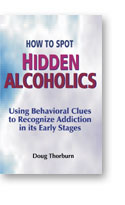
|
|

Loving grandmother so proud of her 3-year-old grandson!
Dear Doug:
I’ve been privileged to care for my 3-year-old grandson weekly since his birth. Because our family lives across the U.S. and appreciates updates on his growing up, I frequently post his pictures on Facebook. The trouble is, one family member responds by posting only negative remarks: his baby blanket is the wrong color, why can’t he be potty trained, his hair is funny looking. She is void of anything positive.
She finally annoyed me so much I deleted her comments from my page. This was a spur-of-the-moment reaction and probably rude. Has any etiquette evolved in regards to Facebook posts? Is there a positive way I could respond to her?
Signed,
Proud Granny
Dear Codependent,
Other columnists might wonder about someone making “disparaging remarks” about a 3-year-old on Facebook and suggest jealousy. I would suggest another possibility: a need to inflate one’s ego by belittling others, which is one of the great early indications of addiction.
Addicts must inflate their egos to perpetuate their addiction and stave off the late stages of the disease, when all they care about is access to their drug. They do this by wielding capricious power over others. One subtle variant is to belittle, as if to say “I’m better than you” and “I could do a better job than you at raising your kid!” It’s sick and barely explicable to the psychologically healthy among us, but she’s doing what addicts do.
Other columnists might point out you can either block her comments or block her access to pictures unless you specifically allow it. They would suggest you might call her and ask whether the two of you can fix the problem. But, those columnists don’t understand addiction. Don’t waste your time; you are almost assuredly dealing with an addict. Until she gets clean and sober, you cannot reason with her. Be forewarned: she may promise to stop—but until she’s sober, her promises are meaningless.
(Source for story idea: “Ask Amy,” June 24, 2014.)
|
|

Story from “This is True” by Randy Cassingham, with his “tagline:”
“That Throbbing Pain: John Martin Novak, 48, of Buhl, Idaho, said he needed sinus surgery to fix a snoring problem. He decided to do the surgery himself. ‘He described that he stuck two straws up his nose,’ the resulting police report says, ‘and was attempting to break his own nose using a door that he would open rapidly and impact his face.’ Novak reportedly told officers that he had been drinking for a week to get ready for the procedures. Police were brought in after he allegedly threatened his sister with a rifle. Officers called in paramedics, and Novak was hospitalized to bring his blood alcohol level down to safe levels — he was at 0.5 percent, which is getting close to lethal levels — and presumably to repair damage to his face. (RC/Magic Valley Times-News) ...The damage to his reputation, however, may be beyond repair.”
Alcoholics experience confabulated thinking and reasoning, which often affects others adversely. This is one instance that affected the addict far more than others, but only initially. Consider the medical costs and who pays them. All of our insurance and tax rates increase because of idiotic medical waste created by the non-thinking of alcohol and other-drug addicts. I’ve estimated that, absent addict-related incidents, overall health care costs would run 25-50% less. The solution, requiring addicts to pay for their own care and fixes when addiction is the true cause of the injury, would do a lot to help addicts think before using and doing awful things, yet again.
By the way, lethal levels for the drug alcohol are much lower than for drugs like heroin. A lethal dose for a heroin addict is 200+ times more than for a non-addict. While alcoholics can get up to a range of .5 to .8 percent blood alcohol level and still be awake, non-alcoholics may be comatose in the .2 to .3 percent range and dead at .35 percent. In that sense, at least, alcohol is by far the more dangerous drug.
(Story and tagline from “This is True,” copyright 2014 by Randy Cassingham, used with permission. If you haven't already subscribed to his newsletter—the free one at least, or the paid one I get, with more than twice the stories—I highly recommend it: www.ThisIsTrue.com.)
|
|

Mass and serial murders are blamed on many things: guns (despite the fact that many such murders are committed without guns), Prozac (even though many occurred prior to its invention) and heavy metal music (which doesn’t explain Hitler’s henchmen gassing Jews to the music of Beethoven) among them. Trevor Grant Thomas, at the often interesting American Thinker blog, debunks the myth that guns are to blame, pointing out that of the ten worst mass murderers in American history only three used guns as their primary means of killing (Seung-Hui Cho, Adam Lanza and George Hennard) and the four worst (Gary Ridgway, Andrew Philip Kehoe, Ted Bundy and John Wayne Gacy) never used guns to kill. While Thomas doesn’t blame Prozac or heavy metal music, he blows it by blaming broken homes and sexual deviancy for creating most mass and serial murderers—not the underlying cause of these issues.
While broken homes and sexual deviancy are common in the lives of horrific murderers, Thomas confuses cause and effect and utterly fails to identify the commonality that likely causes most of them: alcohol or other-drug addiction in either the murderer or a parent. In fact, broken homes and sexual deviancy are two indicators of addiction—even if Jeffrey Dahmer’s adoptive parents remained married throughout. Substance addiction usually explains sexual promiscuity and other forms of what some might call “deviancy,” but unless a 22-year-old virgin could be called deviant, it doesn’t in the case of Elliot Rodger; but it appears he was on a Xanax-fueled murder spree (see “runner-up” in this issue). Cho, whose story is recounted in issue # 29 of TAR and who appears to have had a good family, may have simply been mentally ill. Lanza appears not to have been an addict, but his mother clearly was (“possible codependent of the month” in issue # 73 of TAR. Hennard, Ridgway, Bundy, Gacy and Dahmer were clearly psychotropic drug addicts. Kehoe almost certainly had this disease—cruelty to animals is a near-certain behavioral indication of addiction (check out Kehoe’s fascinating biography).
Thomas also mentions Juan Corona, who likely relapsed into known alcoholism before murdering 25 itinerant laborers in 1971, and Aaron Alexis, whose alcoholism-fueled shooting spree at the Washington Navy Yard is recounted in issue # 75 of TAR.
If mass murders are to be minimized, the root cause of such murders—usually addiction—needs to be identified. Thomas, correctly debunking the myth that guns murder people, links sexual deviancy and bad families to horrific murders. While prevalent, they are not the common thread. Alcohol or other-drug addiction in the perpetrator is the most common cause—and where it doesn’t exist, it usually is found in a parent.
|
Comments
To view reader's comments on last month's Thorburn Addiction Report and Doug's responses please visit the Thorburn Weblog at PrevenTragedy.com.
Thorburn Blog
|
Doug's new book, Alcoholism Myths and Realities, is now available at
GaltPublishing.com, Amazon.com and bookstores near you.
"Every policymaker in America needs to read your book exposing the myths of chemical addiction...Excellent book."
— Jim Ramstad, Member of U.S. Congress (MN)
"My father died of alcoholism. His father died of alcoholism. Three generations of alcoholism is enough. Now is the time to abandon superstition and pseudoscience, to debunk the myths surrounding alcoholism, and to apply science to solving this problem. Doug Thorburn's book is a model example of how this should be done. Read it and be prepared to change your thinking on this important topic. When enough of us understand what is really going on with alcoholism, society can make the shift from treatment to prevention and intervention."
— Michael Shermer, publisher, Skeptic Magazine and columnist, Scientific American
Buy your copy of Alcoholism Myths and Realities for only $14.95 or get the whole collection PLUS a two-hour audio cassette from Galt Publishing for just $49.95 plus tax and shipping. That's a $72.75 value for only $49.95.
To order online, click the following link (be sure to put "TAR SPECIAL" in the comments section of the order form.) Orders can also be placed by phone: 800-482-9424 OR fax: 818-363-3111.
If you wish to pay by check, send the appropriate payment with your shipping information and the words "TAR SPECIAL" in the "memo" section of your check to: PO Box 7777, Northridge, CA 91327.
Click here to purchase any of the above Thorburn books
|

Have you visited the Prevent Tragedy Foundation" The Prevent Tragedy Foundation is a tax-exempt 501c-3 organization, the goal of which is to educate the general public on the need for early detection of alcohol and other drug addiction. The Foundation is intended to answer a question that has been all-but-ignored by similar organizations: what does alcoholism look like before it becomes obvious"
Click here to visit the Prevent Tragedy Foundation |
|
Subscriptions
The Thorburn Addiction Report is a free newsletter published by Galt Publishing and PrevenTragedy.com. Subscibe by visiting our web site at www.PrevenTragedy.com.
|
The Thorburn Addiction Report is available to newspapers as a regular feature column.
Inquiries are invited.
Copyright Doug Thorburn All Rights Reserved.
ALL broadcast, publication, retransmission to e-mail lists, WWW or any other copying or storage, in any medium, online or not, is strictly prohibited without prior written permission from the author. Manual forwarding by e-mail to friends is allowed if 1) the newsletter is forwarded in its entirety and 2) no fee is charged. Please forward no more than three issues to any one person -- after that, they should get their own free subscription. We appreciate people who report violations of our copyright to us.
TO COMMENT to the author,
send your email to report@preventragedy.com or write to
Doug Thorburn, P.O. Box 7777, Northridge, CA 91327-7777
|
 |








